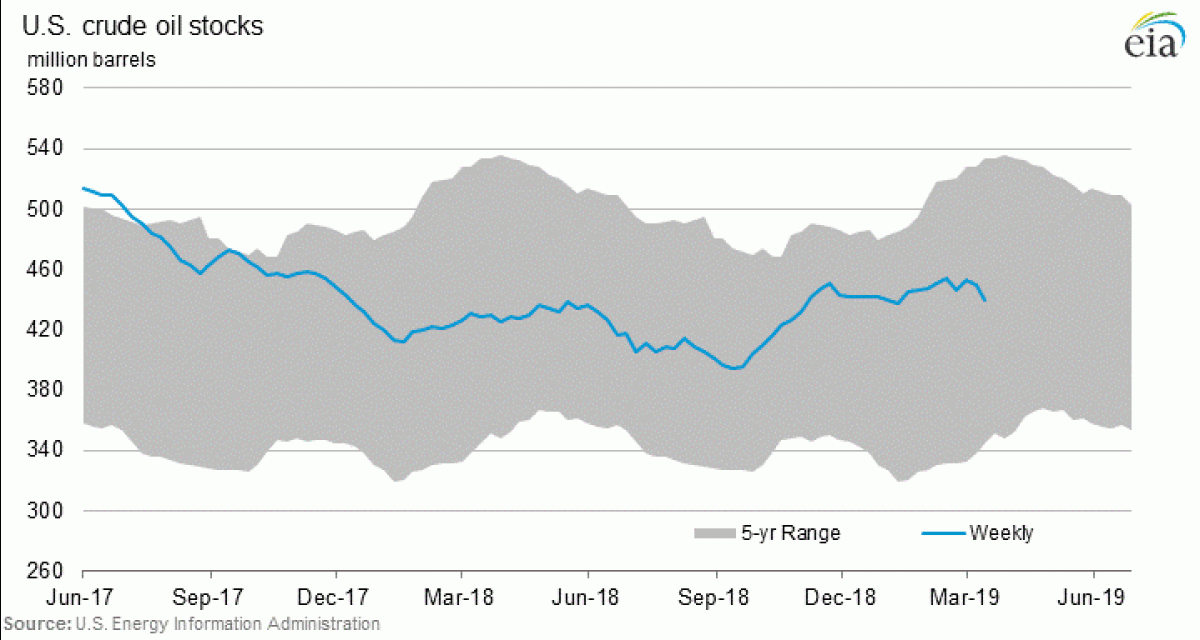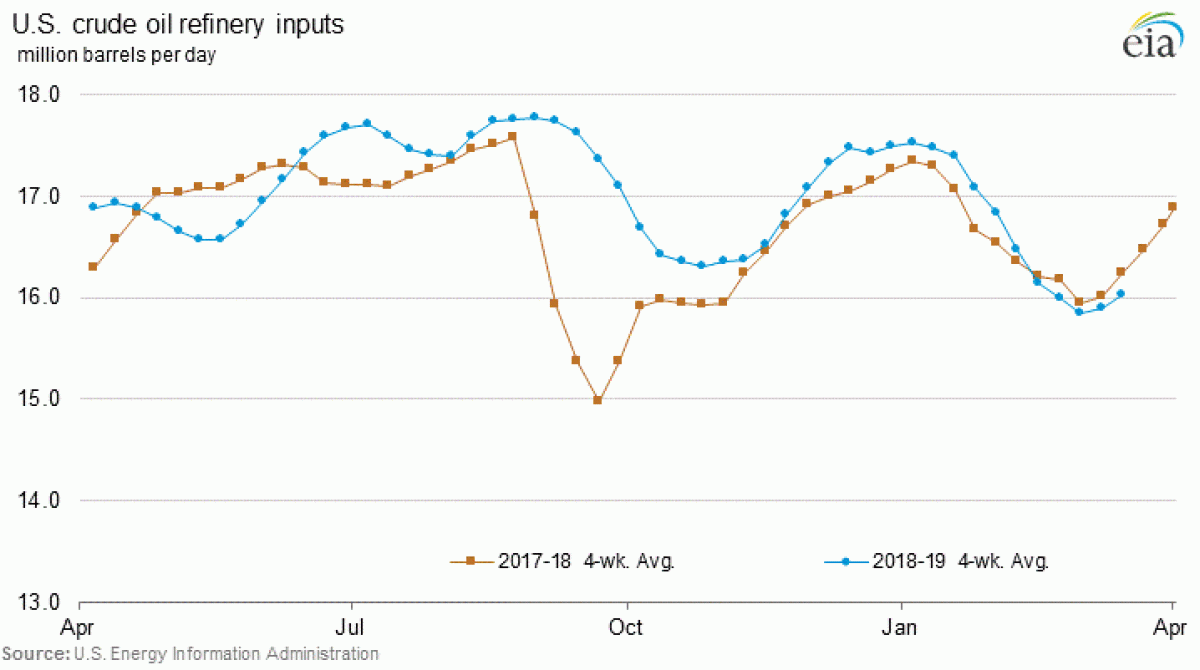Amid oil prices reaching some sort of temporary equilibrium and trading volatility being significantly lower than in the previous weeks, the oil market now expects new impulses that would indicate future direction. Even though the impact of the blackout in Venezuela, second this month, as well as a cooling down of US-China trade talks is more substantial than that of the Deer Park fire in Houston, the oil community was actively speculating about how tough would be the safety regulations that either federal or state authorities are expected to put forward, once they finish their respective investigation.
If reality defies the API’s estimate that US crude inventories rose 1.9MMbbl week-on-week, one can expect a further upward trajectory for oil prices. By Wednesday aftenoon, the global benchmark Brent traded at 67.5 USD per barrel, whilst WTI stopped short of surpassing the 60 USD per barrel mark, trading at around 59.7 USD per barrel.
1. Biggest US Crude Draw in Nine Months
- US Commercial crude stocks have dropped a whopping 9.6 MMbbl week-on-week to 439.5MMbbl on the week ended March 15, the largest drawdown since July 2018, but saw another moderate 2.8 million barrel build for the week ending March 22nd.
- Last week’s draw came on the back of US crude exports surging to 3.4mbpd, while imports rose to 6.9 mbpd.
- As for crude stocks changes on the week ended March 22, the closure of the Houston Ship Channel could have played a…
Amid oil prices reaching some sort of temporary equilibrium and trading volatility being significantly lower than in the previous weeks, the oil market now expects new impulses that would indicate future direction. Even though the impact of the blackout in Venezuela, second this month, as well as a cooling down of US-China trade talks is more substantial than that of the Deer Park fire in Houston, the oil community was actively speculating about how tough would be the safety regulations that either federal or state authorities are expected to put forward, once they finish their respective investigation.

If reality defies the API’s estimate that US crude inventories rose 1.9MMbbl week-on-week, one can expect a further upward trajectory for oil prices. By Wednesday aftenoon, the global benchmark Brent traded at 67.5 USD per barrel, whilst WTI stopped short of surpassing the 60 USD per barrel mark, trading at around 59.7 USD per barrel.
1. Biggest US Crude Draw in Nine Months


- US Commercial crude stocks have dropped a whopping 9.6 MMbbl week-on-week to 439.5MMbbl on the week ended March 15, the largest drawdown since July 2018, but saw another moderate 2.8 million barrel build for the week ending March 22nd.
- Last week’s draw came on the back of US crude exports surging to 3.4mbpd, while imports rose to 6.9 mbpd.
- As for crude stocks changes on the week ended March 22, the closure of the Houston Ship Channel could have played a role in the reported crude build.
- Gasoline inventories dropped 4.6MMbbl week-on-week to 241.5MMbbl during the week ended March 15, with a 190kbpd gasoline output increase coupled with a 56kbpd decline in imports. Gasoline inventories declined by 2.9 million barrels for the week ending March 22nd as refining output decreased by 0.2 million bpd.
- Distillate inventories decreased, too, by 4.1 MMbbl to 132.2MMbbl, and fell once again by 2.1 million barrels for the week ending March 22nd despite falling export levels.
- US refinery utilization rates have started to slowly climb back up, rising 1.3 percent week-on-week to 89 percent.
2. Second Venezuela Blackout Paralyzes Production, Again
- Venezuela suffered another catastrophic blackout Monday, which resulted in all port and blending activities going offline across the country.
- Reportedly the blackout was caused by another incident at the Guri hydropower complex, with one of its sub-stations going ablaze as the state electricity company tried to increase electricity supply.
- PDVSA’s main export terminal in José was forced to cease all operations and evacuate personnel,
- The 3 Orinoco Belt upgraders were dealt another blow, just as repair crews were finishing up with the normalization pressure rates and the unclogging of pipelines.
- At least four crude tankers (and several product-carrying ones) – MT Jag Leela, MT Europride, MT Maran Cygnus and MT Dragon - had to interrupt loading procedures and are waiting for the José terminal to restart operations for the third day already.
3. Iran Willing to Sell More Gas to Turkey

- Iran has been discussing the prospect of increasing natural gas exports to Turkey, indicating that the Turkish political elite might be willing to defy US pressure in order to get a much-coveted price discount.
- The Turkey-Iran talks take place after the Trump Administration has renewed Iraq’s 90-day waiver under which it can continue buying Iranian electricity and gas.
- Should Iran’s gas sales to Iraq continue, they would reach at an annualized rate 9-13 BCm per year (25-35 MCm per day, according to Montazer Torbati, director of NIGC).
- Iran already supplies 10BCm per year of natural gas to Turkey, which given its lack of a coherent national infrastructure, relies on NIGC to feed its southeastern regions.
- Thus, natural gas covers Iran’s domestic energy needs and also allows for some exports, whilst condensate is refined into products at the Persian Gulf Star refinery – freeing up crude for export purposes solely.
4. NNPC Opts For Modest OSP Hikes

- The Nigerian national oil company NNPC has hiked most of its April-loading official selling prices (OSP), yet mostly the increases were modest compared to the last months’ surge.
- NNPC raised Qua Iboe’s OSP by 6 cents to 1.68 USD per barrel above Dated Brent, whilst Bonny Light and new grade Egina saw 3 and 2 cents increases to 1.66 and 1.78 USD per barrel premiums, respectively.
- Heavy grades witnessed the biggest month-on-month increases, the 20° API Ebok was increased by 72 cents to a 0.16 USD per barrel discount vs Dated, whilst 22° API Eremor was hiked by 47 cents to a -4.05 USD per barrel discount.
- In a new reformist drive of reelected President Buhari, NNPC will most likely see its stake in joint ventures with Western majors reduced from the current (sort of obligatory) 60 percent to 40 percent.
5. LUKOIL Sees Caspian Growth Outside Russia

- The largest Russian private oil company LUKOIL sees potential for future expansion in Azerbaijan and Kazakhstan, as the Russian Caspian gradually runs out of steam.
- Upon finalizing all terms with regard to the Zhenis block, where geological exploration will start this year, LUKOIL is in talks to enter another project, preliminarily labelled 1R2.
- Thanks to a more favorable tax regime, Kazakhstan’s offshore has seen some major activity lately, as the Italian oil major ENI, too, had concluded a deal on the nearby Abay block.
- LUKOIL is also negotiating a potential involvement in Azerbaijan’s largest upcoming project, Apsheron, with estimated gas reserves amounting to 350BCm.
- The first phase of Apsheron will go online later this year and with a production rate of 1.5 BCm per year will fully sell its output on the domestic Azeri market.
- So far Apsheron was spearheaded by SOCAR and Total – it is expected that LUKOIL will buy a 10 percent from each.
6. Libyan NOC Rolls Over April OSPs Amid El Sharara Fears

- The Libyan national oil company (LNOC) has rolled over the official formula prices for most of its April-loading cargoes, making only cosmetic changes to the remaining four.
- The largest stream of LNOC, Es Sider, saw its April OSP rolled over at a 0.7 USD per barrel discount to Dated Brent, whilst the second-largest El Sharara remained at a 0.15 USD per barrel discount.
- El Sharara is getting close to its nameplate production capacity of 300kbpd – it climbed to 270kbpd recently – however the operations at the field are still far from being secure.
- Now oil workers have been demanding a long-promised 67 percent salary increase, already promised to them by the government 6 years ago, jeopardizing Libya’s drive to regain 1.2mbpd aggregate production.
- The 40° API Brega and 41-42° API Bu Attifel were one of the few grades which saw their prices dropped – the former by 5 cents to a 0.95 USD per barrel premium to Dated, the latter by 10 cents to a 0.55 USD per barrel discount to Dated.
7. Côte d'Ivoire Exploration Will Be Given a Boost

- The government of Côte d'Ivoire will award six new exploration blocks in a matter weeks, stated the West African nation’s oil minister Abdourahmane Cissé.
- Out of Côte d'Ivoire’s total of 48 exploration blocks 20 are still available, compelling the government to find partners in them so as not to lag behind Ghana and Nigeria.
- It is expected that ENI will get blocks CI-504 and CI-504 next to the Espoir and Foxtrot fields, whilst Total will be awarded CI-705 and CI-706 further to the west of Ivory Coast’s offshore.
- According to market rumours, the French and Italian majors will sign a production sharing deal, taking up at least 85 percent in the venture, with the remaining part going to the national oil company Petroci.
- If the new fields are similar in structure and reserves to existing fields (Espoir, Foxtrot, Acajou etc.), the potential oil should be 27-32° API with a low Sulphur Content of 0.2-0.4 percent.
- Côte d'Ivoire currently produces around 70kbpd of oil equivalent, of which 35kbpd is crude oil, well behind the 200kbpd output volume in neighboring Ghana.






















